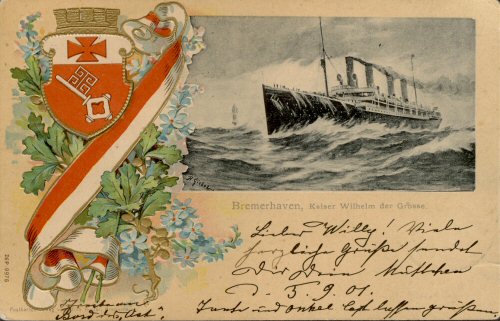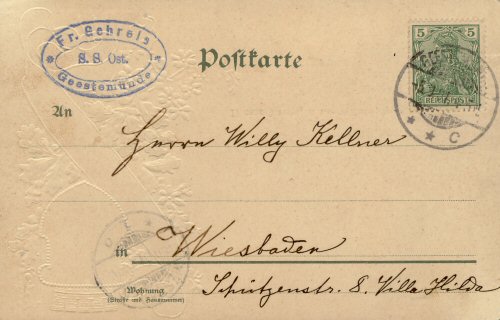
The German merchant marine's first bid to enter the race for supremacy on the North Atlantic passenger run, Norddeutscher Lloyd's Kaiser Wilhelm der Grosse — named for the grandfather of the reigning Wilhelm II—was designed to be the largest and most powerful ship afloat. The first ocean liner with four funnels (only fourteen were built), arranged in two pairs rather than being evenly spaced, the sumptuously decorated ship initiated the era of the superliner. Her prodigious speed was evident from the first, when she made the fastest crossing of any maiden voyage—Bremen to New York via Southampton—in September 1897. Two months later she became the first German ship to capture the Blue Riband by sailing from Sandy Hook to the Needles at an average speed of 22.27 knots. The following March, she set a westbound record with a speed of 22.29 knots. (Both times were bettered by Hamburg-Amerika's Deutschland in 1900.)
In June 1900 she narrowly avoided destruction when a fire broke out at the Norddeutscher Lloyd piers in Hoboken, New Jersey. The fire was the worst in the history of the port of New York, and while she escaped relatively unscathed, her consorts Bremen, Main, and Saale were badly damaged; the last had to be sold. Six years later Kaiser Wilhelm der Grosse was rammed by the British freighter Orinoco off Cherbourg in a collision in which five passengers were killed.
Owing to the profitability of the emigrant trade, in 1914 Kaiser Wilhelm der Grosse was reconfigured to carry only third- and fourth-class passengers, and her few remaining voyages between Bremen and New York were direct. Her last voyage from New York began on July 21 and she was safely back in Bremen at the outbreak of World War I.
Fitted out as an armed merchant cruiser, she sailed from Bremerhaven in the first week of August under command of Captain Max Reymann with a crew of 584. Over the course of the next two weeks she encountered five ships, three of which she sank and two of which she released as they were full of passengers. Starved for fuel, on August 21 she entered the neutral port of Rio de Oro, Spanish Sahara. While refueling from three colliers, she was surprised by HMS Highflyer. After a brief pounding by the cruiser's 6-inch guns, Reymann ordered his ship scuttled, and Kaiser Wilhelm der Grosse sank in 23°34N, 16°2W. There were at least 480 survivors and an unknown number of casualties.
